Abstract
All algae with chloroplasts located not freely in the cytosol, but inside two extra membranes, probably arose chimerically by the permanent fusion of two different eukaryote cells: a protozoan host and a eukaryotic algal symbiont. Two such groups, cryptomonads (phylum Cryptista) and Chlorarachniophyta, still retain a DNA-containing relic of the nucleus of the algal endosymbiont, known as the nucleomorph, as well as the host nucleus. These two phyla were traditionally assumed to have obtained their chloroplasts separately by two independent symbioses. We have sequenced the nuclear and the nucleomorph 18S rRNA genes of the nonphotosynthetic cryptomonad Chilomonas paramecium. Our phylogenetic analysis suggests that cryptomonad and chlorarachniophyte nucleomorphs may be related to each other and raises the possibility that both phyla may have diverged from a common ancestral chimeric cell that originated by a single endosymbiosis involving an algal endosymbiont related to the ancestor of red algae. But, because of the instability of the molecular trees when different taxa are added, there is insufficient evidence to overturn the traditional view that Chlorarachnion nucleomorphs evolved separately from a relative of green algae. The four phyla that contain chromophyte algae (those with chlorophyll c--i.e., Cryptista, Heterokonta, Haptophyta, Dinozoa) are distantly related to each other and to Chlorarachniophyta on our trees. However, all of the photosynthetic taxa within each of these four phyla radiate from each other very substantially after the radiation of the four phyla themselves. This favors the view that the common ancestor of these four phyla was not photosynthetic and that chloroplasts were implanted separately into each much more recently. This probable polyphyly of the chromophyte algae, if confirmed, would make it desirable to treat Cryptista, Heterokonta, and Haptophyta as separate kingdoms, rather than to group them together in the single kingdom Chromista.
Full text
PDF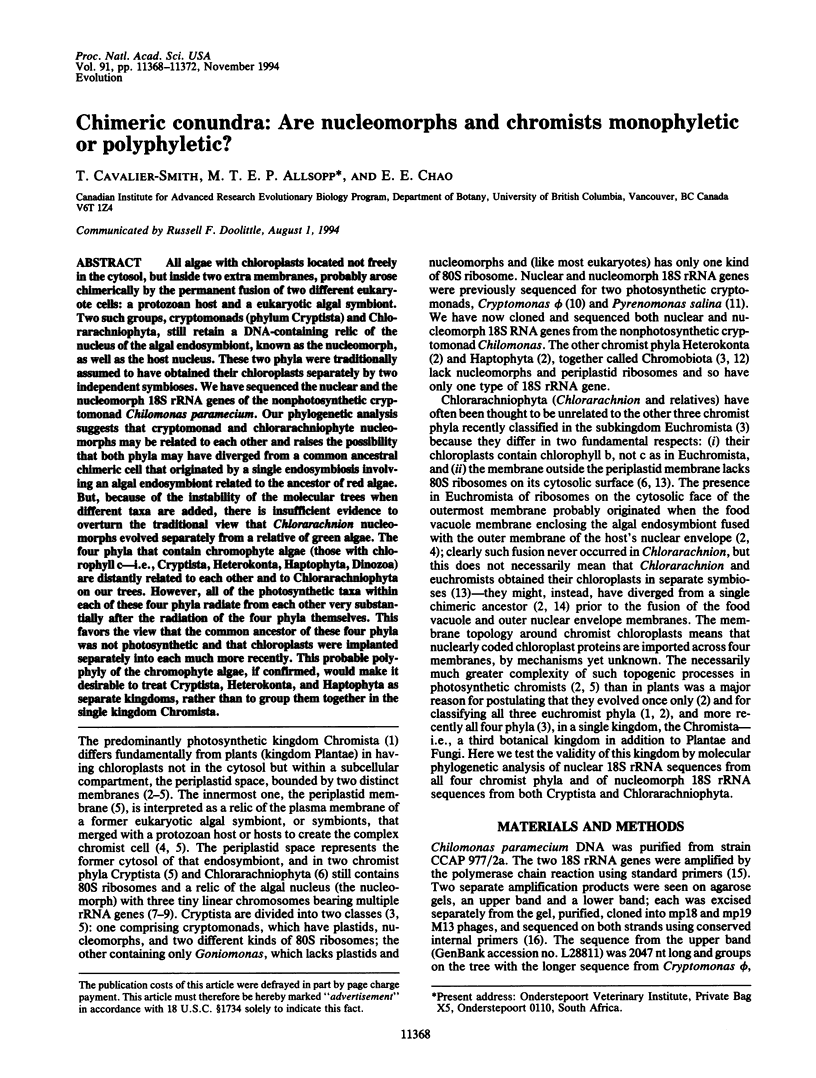
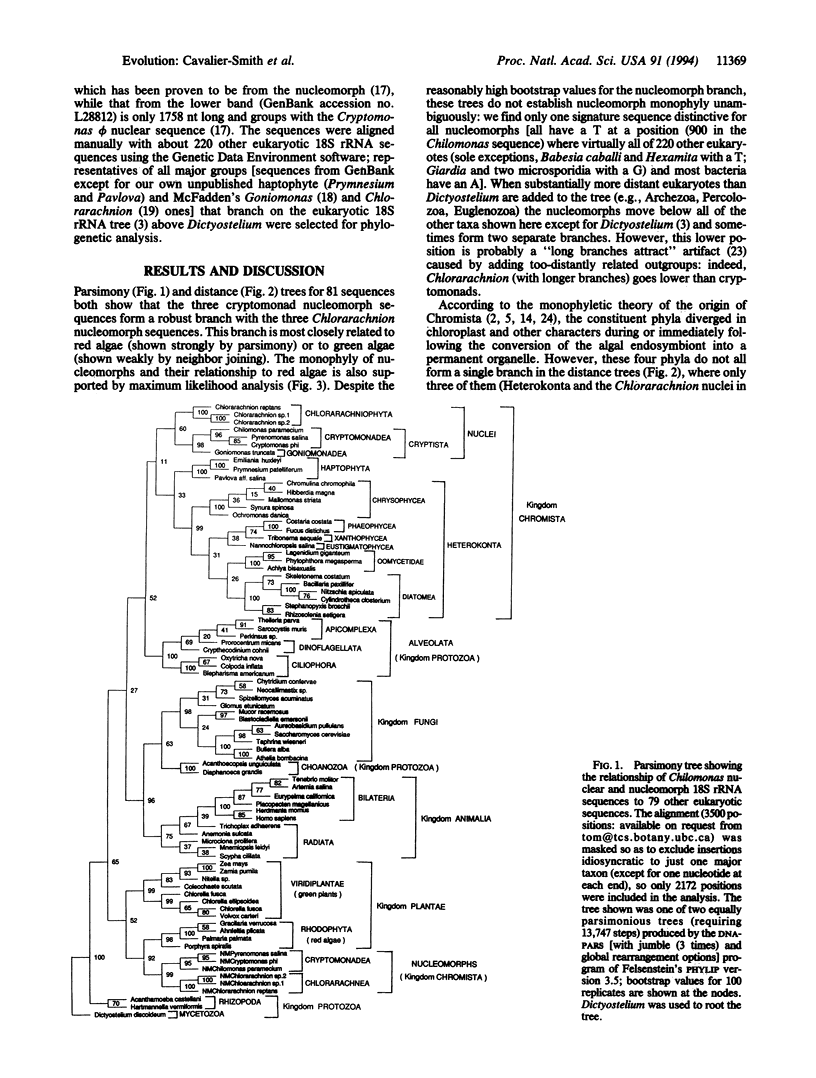
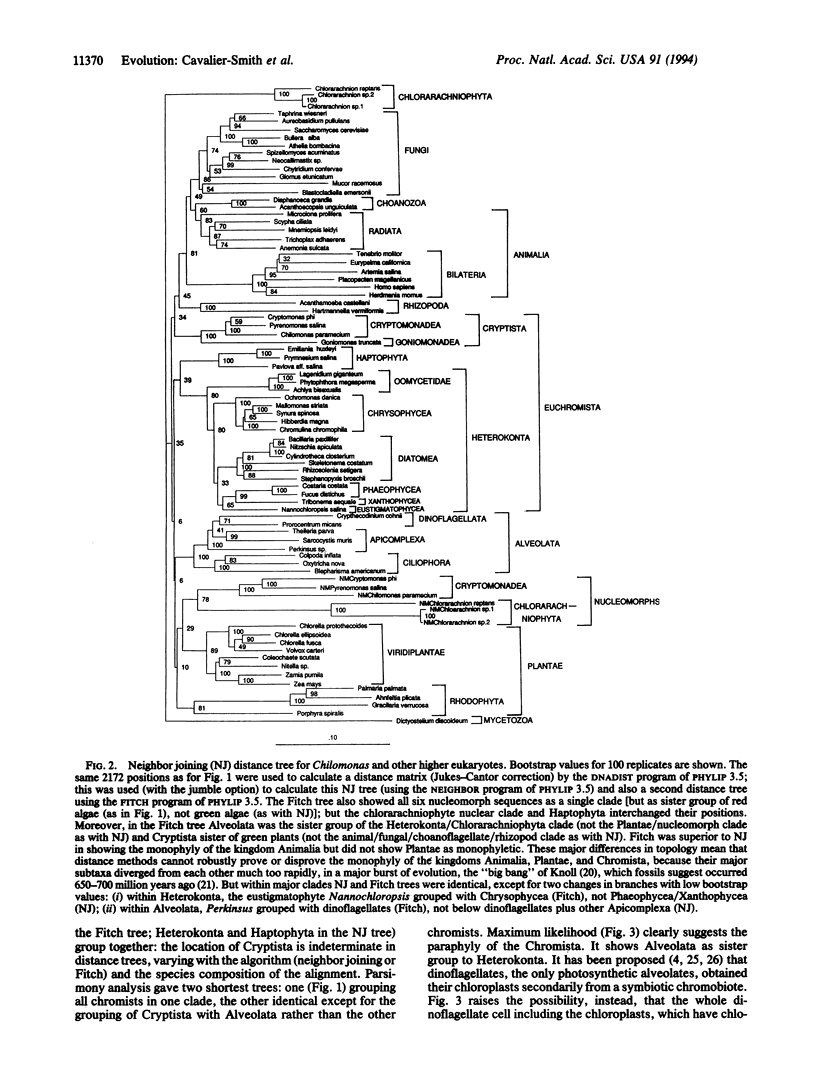
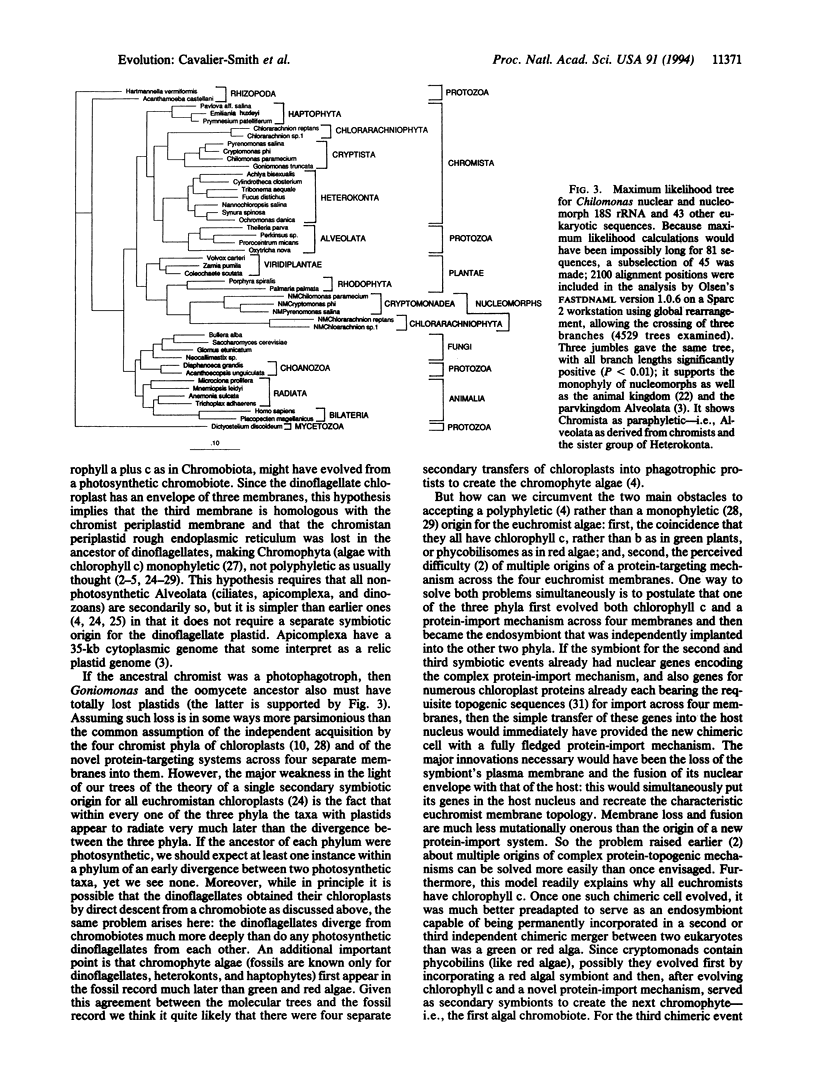
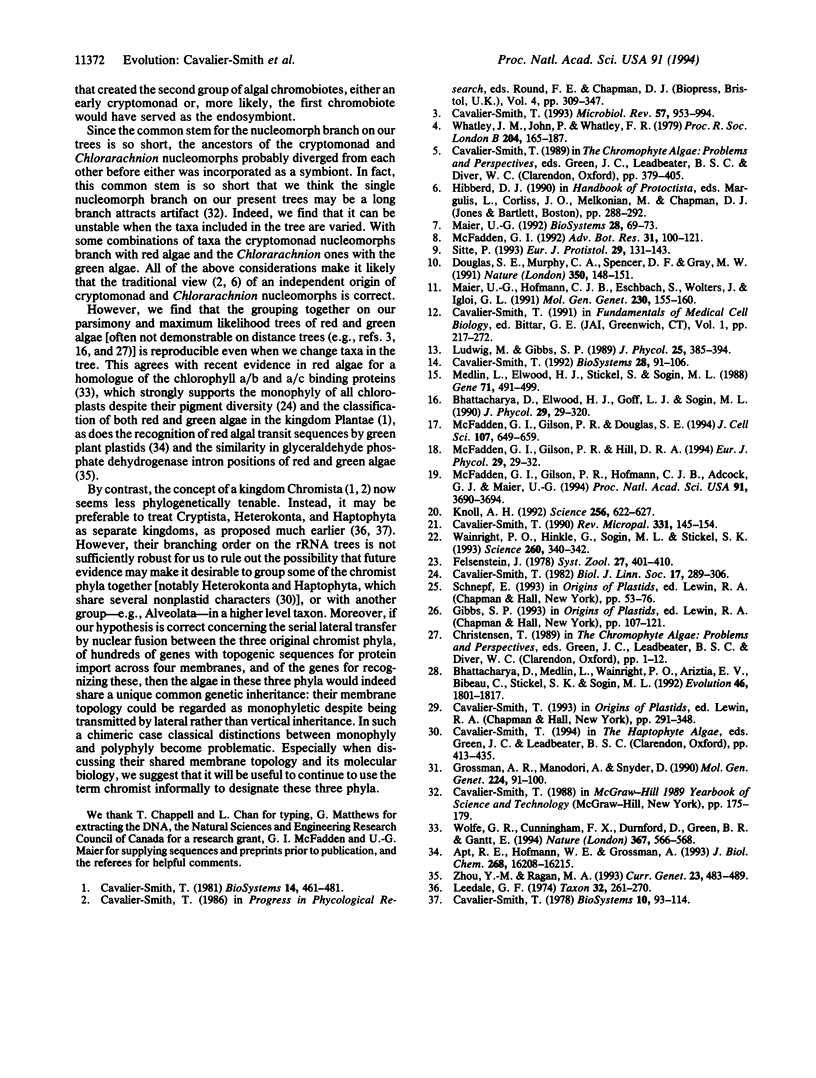
Selected References
These references are in PubMed. This may not be the complete list of references from this article.
- Apt K. E., Hoffman N. E., Grossman A. R. The gamma subunit of R-phycoerythrin and its possible mode of transport into the plastid of red algae. J Biol Chem. 1993 Aug 5;268(22):16208–16215. [PubMed] [Google Scholar]
- Cavalier-Smith T. Eukaryote kingdoms: seven or nine? Biosystems. 1981;14(3-4):461–481. doi: 10.1016/0303-2647(81)90050-2. [DOI] [PubMed] [Google Scholar]
- Cavalier-Smith T. Kingdom protozoa and its 18 phyla. Microbiol Rev. 1993 Dec;57(4):953–994. doi: 10.1128/mr.57.4.953-994.1993. [DOI] [PMC free article] [PubMed] [Google Scholar]
- Cavalier-Smith T. The evolutionary origin and phylogeny of microtubules, mitotic spindles and eukaryote flagella. Biosystems. 1978 Apr;10(1-2):93–114. doi: 10.1016/0303-2647(78)90033-3. [DOI] [PubMed] [Google Scholar]
- Cavalier-Smith T. The number of symbiotic origins of organelles. Biosystems. 1992;28(1-3):91–108. doi: 10.1016/0303-2647(92)90011-m. [DOI] [PubMed] [Google Scholar]
- Douglas S. E., Murphy C. A., Spencer D. F., Gray M. W. Cryptomonad algae are evolutionary chimaeras of two phylogenetically distinct unicellular eukaryotes. Nature. 1991 Mar 14;350(6314):148–151. doi: 10.1038/350148a0. [DOI] [PubMed] [Google Scholar]
- Grossman A., Manodori A., Snyder D. Light-harvesting proteins of diatoms: their relationship to the chlorophyll a/b binding proteins of higher plants and their mode of transport into plastids. Mol Gen Genet. 1990 Oct;224(1):91–100. doi: 10.1007/BF00259455. [DOI] [PubMed] [Google Scholar]
- Knoll A. H. The early evolution of eukaryotes: a geological perspective. Science. 1992 May 1;256(5057):622–627. doi: 10.1126/science.1585174. [DOI] [PubMed] [Google Scholar]
- Maier U. G., Hofmann C. J., Eschbach S., Wolters J., Igloi G. L. Demonstration of nucleomorph-encoded eukaryotic small subunit ribosomal RNA in cryptomonads. Mol Gen Genet. 1991 Nov;230(1-2):155–160. doi: 10.1007/BF00290663. [DOI] [PubMed] [Google Scholar]
- Maier U. G. The four genomes of the alga Pyrenomonas salina (Cryptophyta). Biosystems. 1992;28(1-3):69–73. doi: 10.1016/0303-2647(92)90009-n. [DOI] [PubMed] [Google Scholar]
- McFadden G. I., Gilson P. R., Douglas S. E. The photosynthetic endosymbiont in cryptomonad cells produces both chloroplast and cytoplasmic-type ribosomes. J Cell Sci. 1994 Feb;107(Pt 2):649–657. doi: 10.1242/jcs.107.2.649. [DOI] [PubMed] [Google Scholar]
- McFadden G. I., Gilson P. R., Hofmann C. J., Adcock G. J., Maier U. G. Evidence that an amoeba acquired a chloroplast by retaining part of an engulfed eukaryotic alga. Proc Natl Acad Sci U S A. 1994 Apr 26;91(9):3690–3694. doi: 10.1073/pnas.91.9.3690. [DOI] [PMC free article] [PubMed] [Google Scholar]
- Medlin L., Elwood H. J., Stickel S., Sogin M. L. The characterization of enzymatically amplified eukaryotic 16S-like rRNA-coding regions. Gene. 1988 Nov 30;71(2):491–499. doi: 10.1016/0378-1119(88)90066-2. [DOI] [PubMed] [Google Scholar]
- Wainright P. O., Hinkle G., Sogin M. L., Stickel S. K. Monophyletic origins of the metazoa: an evolutionary link with fungi. Science. 1993 Apr 16;260(5106):340–342. doi: 10.1126/science.8469985. [DOI] [PubMed] [Google Scholar]
- Whatley J. M., John P., Whatley F. R. From extracellular to intracellular: the establishment of mitochondria and chloroplasts. Proc R Soc Lond B Biol Sci. 1979 Apr 11;204(1155):165–187. doi: 10.1098/rspb.1979.0020. [DOI] [PubMed] [Google Scholar]
- Zhou Y. H., Ragan M. A. cDNA cloning and characterization of the nuclear gene encoding chloroplast glyceraldehyde-3-phosphate dehydrogenase from the marine red alga Gracilaria verrucosa. Curr Genet. 1993 May-Jun;23(5-6):483–489. doi: 10.1007/BF00312639. [DOI] [PubMed] [Google Scholar]


